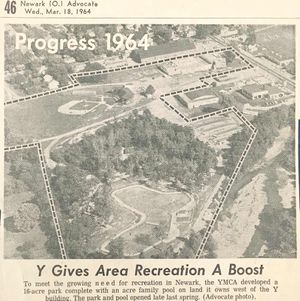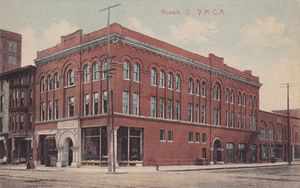Difference between revisions of "YMCA"
(→Early Years of the YMCA in Licking County) |
(→YMCA During World War II and Beyond) |
||
| Line 20: | Line 20: | ||
==YMCA During World War II and Beyond== | ==YMCA During World War II and Beyond== | ||
| − | + | [[File:Y_rec_area.jpg|thumb|alt=Aerial photo showing the YMCA grounds in 1964.|Newspaper clipping from the ''[[Newark Advocate]]'' showing the newly expanded property and facilities of the YMCA on West Church Street in 1964]] | |
During the latter 1930s and early 1940s, membership flourished once again, as the organization adapted to the changes and challenges of supporting the recovering community and the war effort. Higher membership dues helped with remodeling portions of the building to accommodate the many YMCA classes, groups, and other organizations holding meetings and participating in activities. A YMCA sorority, men’s club, and travel club were added during this time. The YMCA also became a USO location for military personnel. By 1943 there were 11,000 participants within 63 organizations at the Y.<ref> "Colorful History Of Local YMCA Passes In Review," ''The Newark Advocate,'' January 20, 1953.</ref> | During the latter 1930s and early 1940s, membership flourished once again, as the organization adapted to the changes and challenges of supporting the recovering community and the war effort. Higher membership dues helped with remodeling portions of the building to accommodate the many YMCA classes, groups, and other organizations holding meetings and participating in activities. A YMCA sorority, men’s club, and travel club were added during this time. The YMCA also became a USO location for military personnel. By 1943 there were 11,000 participants within 63 organizations at the Y.<ref> "Colorful History Of Local YMCA Passes In Review," ''The Newark Advocate,'' January 20, 1953.</ref> | ||
Revision as of 10:03, 2 October 2017
In 1876, 35 men met at a local church to discuss their goals of doing Christian work and bettering their lives. Little did they know that the result of their efforts would improve the health and well-being of men, women, boys, and girls in Licking County into the 21st century. Although the YMCA faced many challenges as it adapted to change during its first 50+ years, the local YMCA would have about 3,700,000 participants in over 40,000 sessions during that time.
Contents
Early Years of the YMCA in Licking County
The group who met in 1876 was led by John H. Franklin, Sr. Franklin dedicated both time and money to the establishment of the YMCA in Newark, and served as its first president. [1]
During the organization’s first ten years, their group performed evangelical work, operated a Sunday school, reading room, and held prayer meetings in a small chapel they had built. In 1890, as their operation began to outgrow their chapel, they moved to an upper floor of the building located at the corner of East Main and East Park Place that once housed Scott’s Furniture. Educational courses, periodical literature, a choral group, and gymnastic instruction were added to their services.
Beginning in 1895, the group began to make plans to raise funds for their own YMCA building at the intersection of West Church and Third Street. In 1899, the YMCA moved in and celebrated in its new building that featured a swimming pool, gymnasium, and auditorium. The organization’s services were expanded beyond just the traditional religious classes. The YMCA began to offer entertainment and a variety of gymnastic classes, as well as the opportunity to use the swimming pool in its programs. According to a YMCA publication, by 1900 there were over 5200 men attending activities.
YMCA in the Twentieth Century
By 1910 the YMCA was operating a night school in addition to its other services, but the overall participation rate in YMCA services suffered greatly during World War I. The war depleted the participation of men of draft-age, leaving most of the participation to the school-age boys. The number of members dropped below 400.
Largely beginning in the 1920s, substantial support for the organization and participation in YMCA activities came from local industries and their families. It is also noted that the Y, as it was called, formed baseball and basketball leagues in the 1920s and 1930s and during that time women and girls were involved in many YMCA activities. There were organized clubs for female members including those for mothers, Girl Scouts, and by 1939, the Gradale Sorority for women. Other organizations were also using the YMCA as a home for their meetings and activities.
By 1925, the growth in membership and programming prompted the YMCA to purchase a new property and plan for future expansion. The new property chosen was at the corner of West Church and Fifth Street. By 1935, the ownership of the property was transferred to the YMCA, from the previous owner, Elizabeth Fuller.
During the depression years, services were economized and the YMCA worked with other organizations and groups utilizing their facilities and services to continue offering many of the classes and activities despite the reduction in their budget.
YMCA During World War II and Beyond

During the latter 1930s and early 1940s, membership flourished once again, as the organization adapted to the changes and challenges of supporting the recovering community and the war effort. Higher membership dues helped with remodeling portions of the building to accommodate the many YMCA classes, groups, and other organizations holding meetings and participating in activities. A YMCA sorority, men’s club, and travel club were added during this time. The YMCA also became a USO location for military personnel. By 1943 there were 11,000 participants within 63 organizations at the Y.[2]
By 1949, the YMCA was again planning on constructing a larger building that would soon be located at 470 West Church Street, where the organization is still located today. The YMCA celebrated the grand opening in January 1953.[3] K.W.
